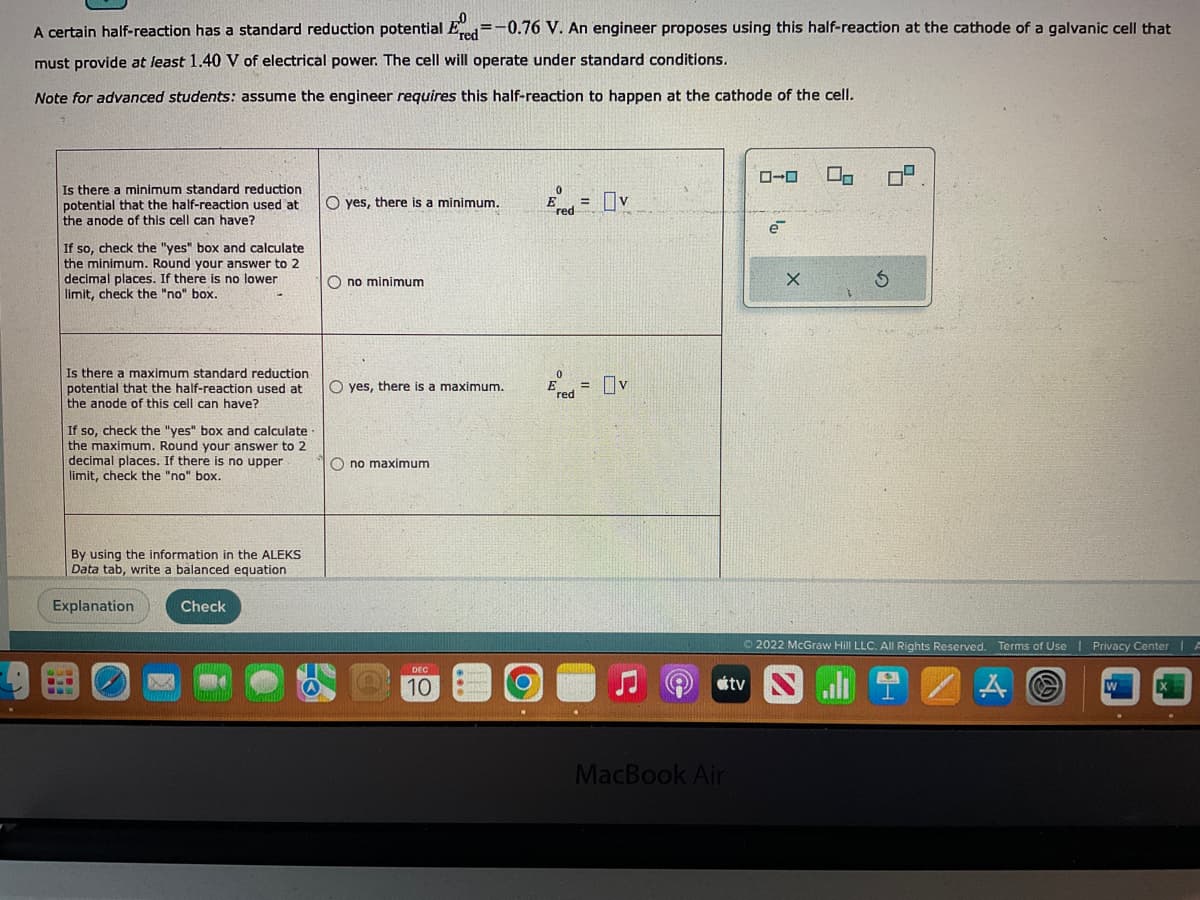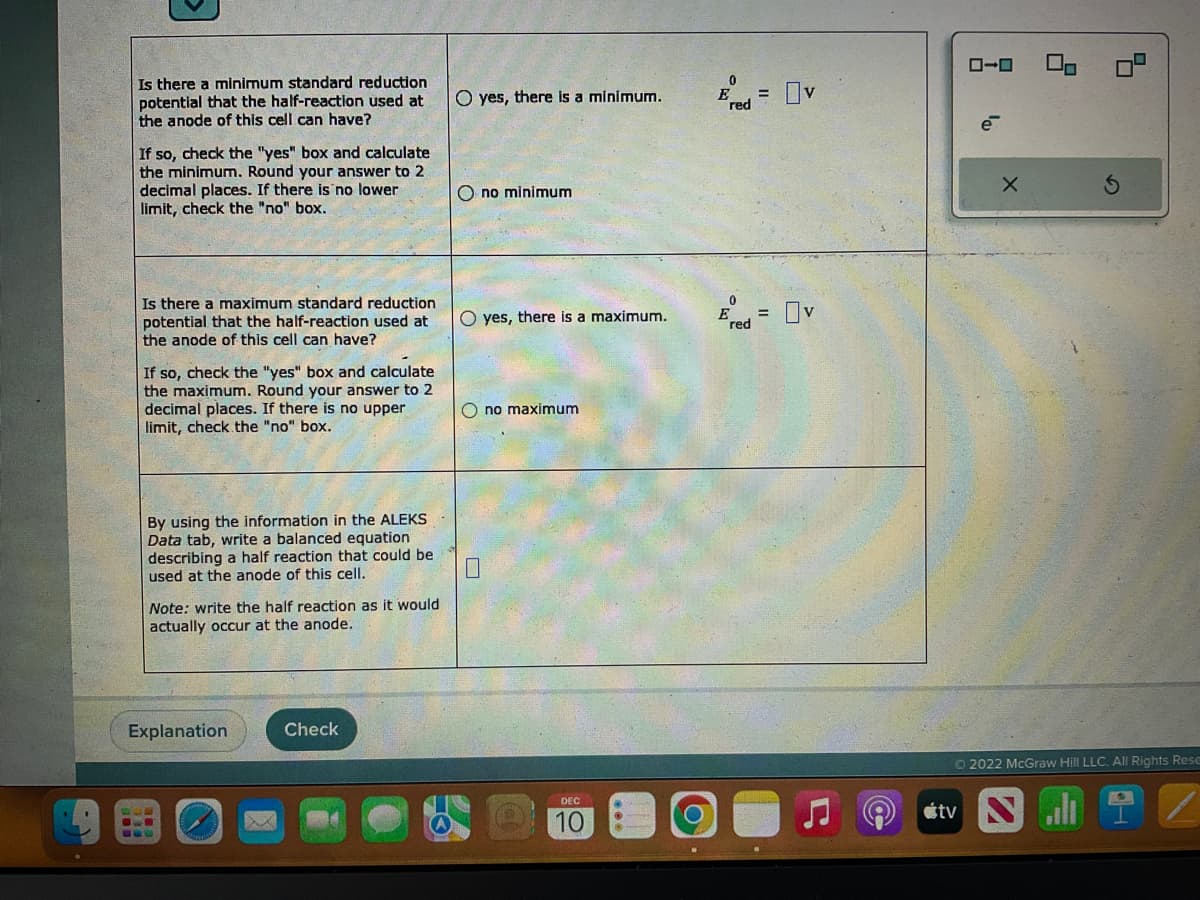A certain half-reaction has a standard reduction potential Ered=-0.76 V. An engineer proposes using this half-reaction at the cathode of a galvanic cell that must provide at least 1.40 V of electrical power. The cell will operate under standard conditions. Note for advanced students: assume the engineer requires this half-reaction to happen at the cathode of the cell. Is there minimum standard reduction potential that the half-reaction used at the anode of this cell can have? If so, check the "yes" box and calculate the minimum. Round your answer to 2 decimal places. If there is no lower limit, check the "no" box. Is there a maximum standard reduction potential that the half-reaction used at the anode of this cell can have? If so, check the "yes" box and calculate the maximum. Round your answer to 2 decimal places. If there is no upper limit, check the "no" box. By using the information in the ALEKS Data tab, write a balanced equation O yes, there is a minimum. O no minimum O yes, there is a maximum. Ono maximum E = v = v red ローロ e X 00
A certain half-reaction has a standard reduction potential Ered=-0.76 V. An engineer proposes using this half-reaction at the cathode of a galvanic cell that must provide at least 1.40 V of electrical power. The cell will operate under standard conditions. Note for advanced students: assume the engineer requires this half-reaction to happen at the cathode of the cell. Is there minimum standard reduction potential that the half-reaction used at the anode of this cell can have? If so, check the "yes" box and calculate the minimum. Round your answer to 2 decimal places. If there is no lower limit, check the "no" box. Is there a maximum standard reduction potential that the half-reaction used at the anode of this cell can have? If so, check the "yes" box and calculate the maximum. Round your answer to 2 decimal places. If there is no upper limit, check the "no" box. By using the information in the ALEKS Data tab, write a balanced equation O yes, there is a minimum. O no minimum O yes, there is a maximum. Ono maximum E = v = v red ローロ e X 00
Chemistry: An Atoms First Approach
2nd Edition
ISBN:9781305079243
Author:Steven S. Zumdahl, Susan A. Zumdahl
Publisher:Steven S. Zumdahl, Susan A. Zumdahl
Chapter17: Electrochemistry
Section: Chapter Questions
Problem 160MP
Related questions
Question
Help with the following question
The 2nd photo is a close up

Transcribed Image Text:A certain half-reaction has a standard reduction potential Ed=-0.76 V. An engineer proposes using this half-reaction at the cathode of a galvanic cell that
must provide at least 1.40 V of electrical power. The cell will operate under standard conditions.
Note for advanced students: assume the engineer requires this half-reaction to happen at the cathode of the cell.
Is there a minimum standard reduction
potential that the half-reaction used at
the anode of this cell can have?
If so, check the "yes" box and calculate
the minimum. Round your answer to 2
decimal places. If there is no lower
limit, check the "no" box.
Is there a maximum standard reduction
potential that the half-reaction used at
the anode of this cell can have?
If so, check the "yes" box and calculate
the maximum. Round your answer to 2
decimal places. If there is no upper
limit, check the "no" box.
By using the information in the ALEKS
Data tab, write a balanced equation
Explanation
935
CO
SOD
Check
M
CERMATTLE uncon
Whemill
O yes, there is a minimum.
Ono minimum
O yes, there is a maximum.
Ono maximum
DEC
10
O
0
E
red
= 0 v
0
Ered = v
AIRLIND
MacBook Air
ローロ
tv
e™
X
Ⓒ2022 McGraw Hill LLC. All Rights Reserved. Terms of Use | Privacy Center
| F
A
A

Transcribed Image Text:Is there a minimum standard reduction
potential that the half-reaction used at
the anode of this cell can have?
If so, check the "yes" box and calculate
the minimum. Round your answer to 2
decimal places. If there is no lower
limit, check the "no" box.
Is there a maximum standard reduction
potential that the half-reaction used at
the anode of this cell can have?
If so, check the "yes" box and calculate
the maximum. Round your answer to 2
decimal places. If there is no upper
limit, check the "no" box.
By using the information in the ALEKS
Data tab, write a balanced equation
describing a half reaction that could be
used at the anode of this cell.
Note: write the half reaction as it would
actually occur at the anode.
Explanation
COO
330
Check
O yes, there is a minimum.
Ono minimum
O yes, there is a maximum.
Ono maximum
0
DEC
10
E = v
red
red
= Ov
ローロ
e
X
8
8
Ⓒ2022 McGraw Hill LLC. All Rights Rese
tv N
ali
Expert Solution
This question has been solved!
Explore an expertly crafted, step-by-step solution for a thorough understanding of key concepts.
Step by step
Solved in 2 steps

Knowledge Booster
Learn more about
Need a deep-dive on the concept behind this application? Look no further. Learn more about this topic, chemistry and related others by exploring similar questions and additional content below.Recommended textbooks for you

Chemistry: An Atoms First Approach
Chemistry
ISBN:
9781305079243
Author:
Steven S. Zumdahl, Susan A. Zumdahl
Publisher:
Cengage Learning


Chemistry
Chemistry
ISBN:
9781305957404
Author:
Steven S. Zumdahl, Susan A. Zumdahl, Donald J. DeCoste
Publisher:
Cengage Learning

Chemistry: An Atoms First Approach
Chemistry
ISBN:
9781305079243
Author:
Steven S. Zumdahl, Susan A. Zumdahl
Publisher:
Cengage Learning


Chemistry
Chemistry
ISBN:
9781305957404
Author:
Steven S. Zumdahl, Susan A. Zumdahl, Donald J. DeCoste
Publisher:
Cengage Learning

Principles of Modern Chemistry
Chemistry
ISBN:
9781305079113
Author:
David W. Oxtoby, H. Pat Gillis, Laurie J. Butler
Publisher:
Cengage Learning

Principles of Instrumental Analysis
Chemistry
ISBN:
9781305577213
Author:
Douglas A. Skoog, F. James Holler, Stanley R. Crouch
Publisher:
Cengage Learning

Chemical Principles in the Laboratory
Chemistry
ISBN:
9781305264434
Author:
Emil Slowinski, Wayne C. Wolsey, Robert Rossi
Publisher:
Brooks Cole